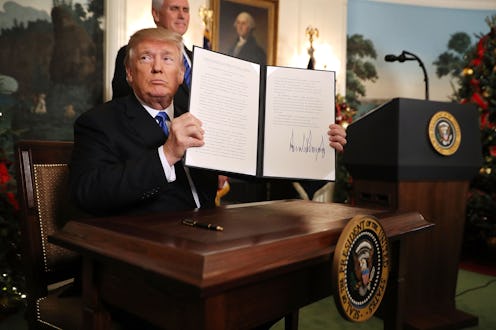News
There Are White House Employees Who Literally Tape Up Documents Trump Tore Apart

If you thought Meryl Streep’s caricature of Anna Wintour in the hit movie The Devil Wears Prada portrayed a boss's actions as too outlandish, take a seat. There are apparently actual government employees who tape President Donald Trump's papers back together, according to a new report from Politico. Bustle has reached out to the White House for comment on the claims.
Politico's sources described Trump's habit of ripping up official documents as his "filing system." It's a habit that's reportedly endured during his nearly 17 months in the White House, despite laws that require preserving presidential papers. The law, called the Presidential Records Act, is pretty clear on the subject.
According to the National Archives, all "documentary material" must be preserved for the future. But what is documentary material? It includes almost anything medium of an official record that could be created by a person that you can think of. Per the National Archives:
The term "documentary material" means all books, correspondence, memoranda, documents, papers, pamphlets, works of art, models, pictures, photographs, plats, maps, films, and motion pictures, including, but not limited to, audio and visual records, or other electronic or mechanical recordations, whether in analog, digital, or any other form.
So, to make sure Trump does not violate the law, White House aides have taken to picking up the president's scraps, according to Politico. Then, employees like Solomon Lartey, a records management analyst, reassemble the pieces using Scotch tape, according to interviews.
The papers, regardless of content couldn't be sent to the National Archives for saving until they were put back in tact. "We got Scotch tape, the clear kind," Lartey told Politico. "You found pieces and taped them back together and then you gave it back to the supervisor."
Trump apparently tore up papers regardless of content. Politico reported the torn documents included handwritten notes by Trump, letters from lawmakers, newspaper clippings with circled words, among others.
"I had a letter from [Senate Minority Leader Chuck] Schumer. He tore it up," Lartey told Politico. "It was the craziest thing ever. He ripped papers into tiny pieces."
Another of the bureaucrats responsible to taping up the president's papers was Reginald Young, Jr., who worked as a a senior records management analyst, according to Politico. "I’m looking at my director, and saying, 'Are you guys serious?' We're making more than $60,000 a year, we need to be doing far more important things than this. It felt like the lowest form of work you can take on without having to empty the trash cans," the career government employee told the news outlet.
Both Lartery and Young were terminated earlier this spring and described the termination as abrupt. The White House and human resources did not respond to Politico's requests for comment.
In March 2017, the National Archives assured lawmakers that Trump's tweets — even the deleted and corrected ones — were being saved by the White House for the official record.
David S. Ferriero, the head of the National Archives, said the White House counsel's office was briefed on the Presidential Records Act in February 2017, shortly after Trump was inaugurated, according to the Associated Press. It's not clear how the White House is preserving individual tweets, but the same report said the Obama administration used an automated system to preserve each of then-President Barack Obama's tweets.
Obama was considered the first social media president as he was in office when social media networks such as Facebook, Instagram, Twitter, and Snapchat became ubiquitous among his constituents' lives. Beyond the official record held by the National Archives, a number of citizen-led initiatives popped up after Obama left office to preserve his digital footprint. These included a searchable GIF archive, Twitter bots and interactive tools showing White House talking points and the public's responses, among others.